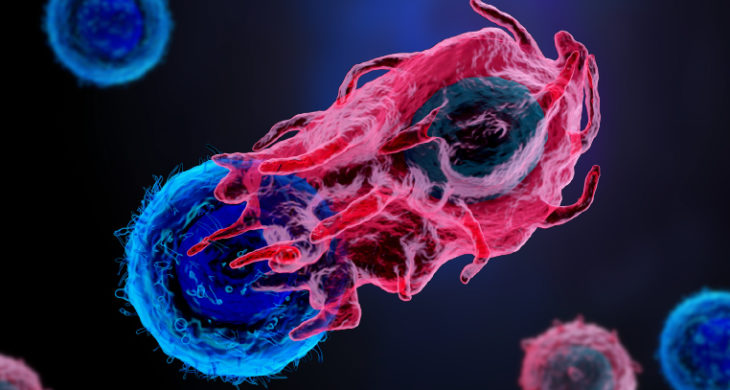
Date: 14th September 2021
Immunotherapy drugs are promising new weapons especially in the fight against cancer, and are changing the standard of care for patients. Aimed to stimulate or suppress the immune system, molecules such as immune stimulatory antibodies and cytokines elicit a potent antitumour immunity. However, these types of drugs carry risk, and dose-limiting systemic toxicity has greatly hindered their translation from preclinical to clinical applications. Now, researchers have developed a chemical ‘shielding’ method termed switchable immune modulator (Sw-IM), whereby the immunotherapy proteins are masked, staying inert in the circulation and healthy tissue, and are only switched on upon entry to the tumour, thereby ameliorating their toxicity.
The therapeutic potential of immune stimulatory agonistic antibodies and cytokines has been hampered by the severe systemic toxicity derived from the excessive activation of immune and inflammatory responses. Attempts to circumvent system toxicity are currently under scrutiny such as localised or targeted delivery to the tumour however, these approaches often carry their own set of undesirable risks. An alternative strategy also being explored is to achieve selective activation of immune modulators in the tumour microenvironment (TME) regardless of their biodistribution. Some success developing antibody prodrugs masked by recombinant fusion peptides or protein domains in response to tumour-associated proteases has already been reported but these works are still embryonic and have been limited to antibody-based drugs.
Now, researchers at École Polytechnique Fédérale de Lausanne, France, led by Li Tang, have used biocompatible polymers to reversibly block immune modulators, through responsive covalent linkers degradation occurred in response to stimuli specifically in the TME, reactivating the immunotherapy proteins.
Properties of the TME differ from the rest of the body, and contain a high reducing potential and acidic pH. The team exploited these attributes and used a hydrophilic, biocompatible polymer with low immunogenicity, conjugated to the drug of choice via a traceless redox-responsive linker to mask or inactivate the drug.
The first potent cancer immunotherapy drug the team focused on was anti-4-1BB, an agonist antibody, that stimulates tumour necrosis factor receptor superfamily member 9 (TNFRSF-9), but in the clinic its use has been hindered by hepatoxicity. They prepared a series of redox-responsive switchable anti–4-1BB antibodies (Swredoxa4-1BB), and showed that it was indeed responsive to redox potential.
In mice bearing tumours, treatment with Swredoxa4-1BB mitigated the effect of splenomegaly which occurred with treatment of the native anti–4-1BB antibody. They had reduced nonspecific expansion of effector and cytotoxic T cells in spleen when compared to the native anti–4-1BB antibody cohort, thereby showing enhanced safety profile, and liver damage was also decreased - suggesting the alleviation of systemic immunotoxicity. Importantly, a reduction in drug efficacy was not observed.
The Sw-IM strategy is highly versatile and modular, to prove this the team in total synthesised 58 different Sw-IMs – each consisting of three modular parts 1) a protein-based therapeutic, 2) a responsive linker, and 3) a biocompatible polymer for reversible masking. In addition to Swredoxa4-1BB, they also included a more in depth study of a cytokine superagonist, IL-15SA, and checkpoint blockade antibodies, anti–PD-1 and anti–CTLA-4, and used both redox and acidic pH–responsive linkers. The data suggested overall an enhanced performance of Sw-IMs with potentially equivalent or increased antitumor activity (compared with native parental forms) but with a significant reduction of toxicity in healthy tissues. The prepared Sw-IMs remained at off status in peripheral blood and healthy tissues but rapidly switched on in the TME with regained immune stimulating activities.
Conclusions and future applications
The team here have designed a responsive chemical masking strategy, dubbed Sw-IM, to achieve tumour-specific activation of IMs, markedly reducing immunotoxicity, whilst retaining therapeutic potency. This lead to prolonged survival of tumour bearing mice.
The power of this strategy is modularity and flexibility. Besides the redox and acidic pH–responsive chemistry demonstrated here, other environmental cues can in the future be harnessed, such as responsiveness to matrix metalloproteinases, reactive oxygen species, or even external signals such as light. Any biomacromolecule agents bearing multiple functional groups could potentially be formulated into Sw-IMs, and applications could be extended to nonprotein therapeutics or imaging probes.
This work should add to the ongoing efforts to minimise systemic toxicity of drugs and therapies, and to target specific cells or tissues. Technological advances have rapidly progressed a wide range of strategic solutions, whether this is optical remote control for gene transfer, sonothermogenetics – a nonivasive thechnology that focused ultrasound to stimulate cell-type specific activation of neurons, or ‘SMART’ engineered stem cells that sense changing levels of endogenous inflammatory cytokines and trigger a therapeutic response. Even more simple strategies such as saline-formulated mRNA therapies are also proving to diminish off-target systemic adverse effects.
Together, these new and innovative approaches will hope to change the standard of care for patients with cancer or a wide range of diseases, by improving the therapeutic window and clinical applicability of the most potent drugs, through limiting and targeting their place of activation or action.
For more information please see the press release at EPFL
Zhao, Y., Xie, Y.-Q., Herck, S.V., Nassiri, S., Gao, M., Guo, Y., and Tang, L. (2021). Switchable immune modulator for tumor-specific activation of anticancer immunity. Science Advances 7, eabg7291.
https://doi.org/10.1126/sciadv.abg7291

